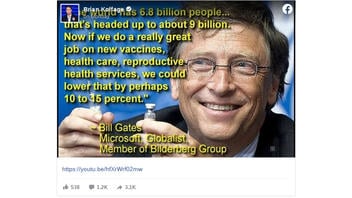
Did Bill Gates really suggest eliminating about 10 to 15 percent of the global human population using vaccines during a TED talk in 2010? No, that's not true: Gates' remark was about possible strategies to slow down population growth in order to reduce CO2 emissions. In the larger context of his talk Gates is saying this strategy does not help much with emissions and the whole point of his talk is that more resources should be spent on technologies like new types of nuclear power plant. Near the end of his speech he actually says he would prefer having a more efficient zero-emission power generation technology over having a new vaccine.
The isolated quote is often used out of context to suggest Gates wants to eliminate or kill millions of people to advance some sort of nefarious agenda.
An example of the quote being used in such a way can be seen in the image included in this recent Facebook post (archived here) where it was published by Brian Kolfage on May 26, 2020. It adds the name of the Bilderberg Group (who organise an annual conference Gates visited in 2010) and the word "Globalist" to give the impression the quote is part of some larger plan.
This is what the post looked like on Facebook at the time of writing:
Here is the actual quote from Gates' 2010 Ted Talk titled "Innovating to zero!":
First, we've got population. The world today has 6.8 billion people. That's headed up to about nine billion. Now, if we do a really great job on new vaccines, health care, reproductive health services, we could lower that by, perhaps, 10 or 15 percent. But there, we see an increase of about 1.3.
However this has to be looked at in the larger context of the speech. Gates is talking about the need to reduce CO2 emissions by humans and he presents this formula for calculating how big these emissions are: CO2 = P x S x E x C (= People x Services per Person x Energy per Service x CO2 per unit of Energy)

(Source: Bill Gates slide deck)
It is a mathematical rule that to get something to zero by multiplying you have to multiply it by zero. So, Gates is saying, if you want zero CO2 emissions one of the values on the other side of the equation will have to be zero.
He then goes over them one by one and lists why that wouldn't be practical, ethical or even possible, except maybe with "CO2 per Unit of Energy".
It is in this context that the quote about "Population" should be understood. Can you bring that number to zero? Of course you can: kill everybody on the planet. But Gates is not suggesting doing that at all. He is simply pointing out there are 6.8 billion people today and there are projected to be 9 billion in the future before growth levels off, an increase of 2.2 billion. He argues it might be possible to reduce that growth a bit, knocking 10 or 15 percent of the increase. But that would still mean you would end up with 8.78 billion people instead of 9 billion, an increase of roughly 1.3 (instead of a decrease to zero).
So, what about the remarks about "new vaccines, health care, reproductive health services"? That is just what specialists studying population growth are saying. As people get richer they get more access to better healthcare so they stop having lots of babies because the risk of their children dying at an early age takes a steep dive. This means the total population stabilizes and stops growing after a while.
Here is professor Hans Rosling from Gapminder explaining this principle:
In this short video Professor Hans Rosling shows that people living in poverty have many children. The poor families suffer from high child mortality, and the largest population growth occurs where people are poor. Parents in richer communities expect their children to survive, which is one of the reasons they decide to have fewer babies.
Saving poor children is an important factor in ending both poverty and population growth. The death of children is not holding back population growth. It is one of the reason poor people still have many children.
Gates goes on in his talk to speak about the "Services" and "Efficiency" parts of the equation too, concluding there is some gain to be made there but not enough to get the numbers down to zero either:
The second factor is the services we use. This encompasses everything: the food we eat, clothing, TV, heating. These are very good things. Getting rid of poverty means providing these services to almost everyone on the planet. And it's a great thing for this number to go up. In the rich world, perhaps the top one billion, we probably could cut back and use less, but every year, this number, on average, is going to go up, and so, overall, that will more than double the services delivered per person. Here we have a very basic service: Do you have lighting in your house to be able to read your homework? And, in fact, these kids don't, so they're going out and reading their schoolwork under the street lamps.
Now, efficiency, "E," the energy for each service -- here, finally we have some good news. We have something that's not going up. Through various inventions and new ways of doing lighting, through different types of cars, different ways of building buildings -- there are a lot of services where you can bring the energy for that service down quite substantially. Some individual services even bring it down by 90 percent. There are other services, like how we make fertilizer, or how we do air transport, where the rooms for improvement are far, far less. And so overall, if we're optimistic, we may get a reduction of a factor of three to even, perhaps, a factor of six. But for these first three factors now, we've gone from 26 billion to, at best, maybe 13 billion tons, and that just won't cut it.
Finally he lands on the topic of "CO2 per unit of energy":
So let's look at this fourth factor -- this is going to be a key one -- and this is the amount of CO2 put out per each unit of energy. So the question is: Can you actually get that to zero? If you burn coal, no. If you burn natural gas, no. Almost every way we make electricity today, except for the emerging renewables and nuclear, puts out CO2. And so, what we're going to have to do at a global scale, is create a new system. So we need energy miracles.
Gates then goes on describing some possible solutions, including new nuclear power plant designs, that could lead to zero-emission power generation, before concluding:
If you gave me only one wish for the next 50 years -- I could pick who's president, I could pick a vaccine, which is something I love, or I could pick that this thing that's half the cost with no CO2 gets invented -- this is the wish I would pick.
In other words: Bill Gates would prefer seeing new zero-emission power generation technologies being invented over getting a better and newer vaccine.
So what Gates is saying in his TED talk is almost the opposite of what people using the quote in isolation are claiming. Gates is making the point that reducing the population to zero or even slowing down the growth is not a practical option to stop CO2 emissions and that better power generaton technology would be a better solution.













